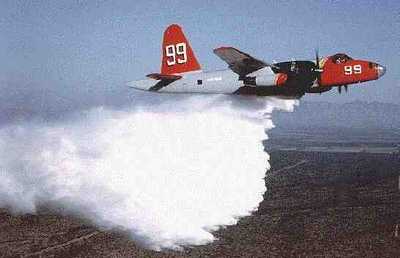(The following editorial appeared in the Monday edition of the
Missoula Missoulian and is reprinted with permission --
ed.)
Neptune Aviation flies aerial tankers that were built for war to
combat hellish wildfires, but their toughest mission ever appears
to be navigating a federal bureaucracy that grounded the
Missoula-based firefighting force pending near-absolute proof that
its aging but well-maintained aircraft are airworthy.

In May, the US Forest Service and Department of the Interior
abruptly canceled contracts with Neptune and several other air
tanker companies providing a total of 33 large planes used to dump
retardant on wildfires throughout the West. That decision followed
an investigation by the National Transportation Safety Board of two
aerial tanker crashes in 2002. The decision to cancel the contracts
was based not on any hard evidence that the air tanker force isn't
safe. Rather, it was the NTSB's declaration that airworthiness
needed to be assured through a more thorough oversight program -
and that the Forest Service is responsible for ensuring
airworthiness. Previously, the Forest Service believed that was the
Federal Aviation Administration's job.
Interestingly, the NTSB report didn't single out heavy air
tankers. Its findings applied to any and all aircraft hired by the
Forest Service. The Forest Service may be focusing on the large
tankers because they are mostly older ex-military planes subjected
to potentially great stresses in fighting fires. But the selective
reading - or at least application - of the NTSB findings has a lot
of us scratching our heads.
 What's transpired since the contract
cancellation has been much like ping-pong played through a smoke
screen. The Forest Service has struggled to detail the information
it needs to determine airworthiness. Neptune has turned itself
inside out to provide it. A clean bill of health from the
contractor hired by the Forest Service to evaluate Neptune's planes
and maintenance wasn't enough. Now the Forest Service says it also
needs data about the "operational life limit" - essentially, the
life span of the plane established by the manufacturer when the
planes were built. Or not. Operational life limits may not exist
for all planes. Manufacturer Lockheed Martin is now working to
produce the data the Forest Service is demanding. This all seems
aimed at proving a negative - not that the planes are safe but,
rather, that they absolutely aren't unsafe.
What's transpired since the contract
cancellation has been much like ping-pong played through a smoke
screen. The Forest Service has struggled to detail the information
it needs to determine airworthiness. Neptune has turned itself
inside out to provide it. A clean bill of health from the
contractor hired by the Forest Service to evaluate Neptune's planes
and maintenance wasn't enough. Now the Forest Service says it also
needs data about the "operational life limit" - essentially, the
life span of the plane established by the manufacturer when the
planes were built. Or not. Operational life limits may not exist
for all planes. Manufacturer Lockheed Martin is now working to
produce the data the Forest Service is demanding. This all seems
aimed at proving a negative - not that the planes are safe but,
rather, that they absolutely aren't unsafe.
In the meantime, a relatively tame fire season has muted the
fallout from the lack of large air tankers for firefighting. The
agency has instead relied on other aircraft. Success in fire
suppression has been high, but four single-engine tankers have
crashed this season. Only the large tankers have been grounded,
however.
We don't know much about airplanes - certainly nothing about
metallurgical stresses, operational life limits and other technical
issues needed to certify planes as airworthy. Our guess is that, as
an agency, the Forest Service knows next to nothing. The Forest
Service is a land- and resource-management agency. Much of the
difficulty and confusion involving the canceled air tanker
contracts might be attributable to the fact that the Forest Service
is trying to reinvent the wheel.
The NTSB may be legally correct when it assigns the Forest
Service responsibility for ensuring airworthiness of aircraft. But
surely that's a job that could be better done by the FAA. Congress
ought to legislate a change clarifying the FAA has jurisdiction
over so-called public-use aircraft hired by the Forest Service, if
not all government agencies.
 Last week, Forest Service officials
said they're going to work on plans to modernize the planes used
for firefighting. Sounds expensive as all get-out! Even if Congress
antes up the money to do that, surely it would be years before the
agency realizes that goal. Even then, the aircraft used to fight
fires likely would be newer, but not new. Airworthiness of the
aircraft it owns and employs will be an ongoing issue.
Last week, Forest Service officials
said they're going to work on plans to modernize the planes used
for firefighting. Sounds expensive as all get-out! Even if Congress
antes up the money to do that, surely it would be years before the
agency realizes that goal. Even then, the aircraft used to fight
fires likely would be newer, but not new. Airworthiness of the
aircraft it owns and employs will be an ongoing issue.
It seems wasteful to divert precious resources and occupy a
land-management agency with the task of creating, maintaining,
evaluating and certifying its own air force.
The Forest Service needs the ability to fight fires from the air
as part of the combined attack it needs to manage wildlands and
protect the public. Private companies have proved highly capable in
providing that capability under contract. The Forest Service needs
the planes it employs to be safe, and the contractors need a
reasonable and predictable opportunity to certify their aircraft.
The FAA certifies other commercial aircraft, and it seems silly to
create redundant capability within the Forest Service.
 ANN's Daily Aero-Term (04.20.24): Light Gun
ANN's Daily Aero-Term (04.20.24): Light Gun Aero-News: Quote of the Day (04.20.24)
Aero-News: Quote of the Day (04.20.24) ANN's Daily Aero-Linx (04.21.24)
ANN's Daily Aero-Linx (04.21.24) Aero-News: Quote of the Day (04.21.24)
Aero-News: Quote of the Day (04.21.24) ANN's Daily Aero-Term (04.21.24): Aircraft Conflict
ANN's Daily Aero-Term (04.21.24): Aircraft Conflict





